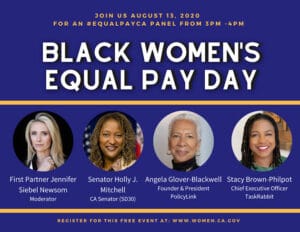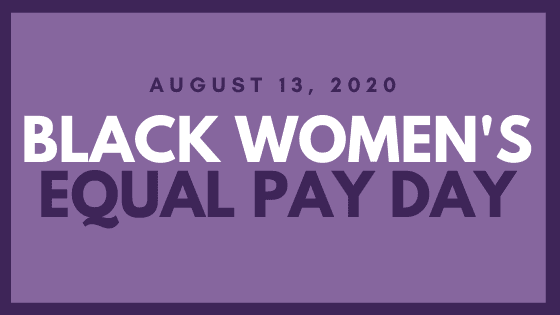National Black Women’s Equal Pay Day – September 21, 2022, history significance why we celebrate
Institutional racism is a thing, and combating it is a large part of the reason for observing Black Women’s Equal Pay Day, which takes place annually on a date set by a national group of advocates. This year, it takes place on September 21.
In 2020, 226 days passed before African and Black American women had reached that point, without regard to job type and required education. On National Black Women’s Equal Pay Day, let your voice join the courageous activists rallying to influence leaders, disseminate crucial knowledge, and make pay equity a reality.
HISTORY OF NATIONAL BLACK WOMEN’S EQUAL PAY DAY

Back in 1996, an organization called the National Committee on Pay Equity declared the observation of Equal Pay Day. The coalition of labor unions, professional associations, civil rights organizations and individuals has been fighting ever since to open people’s eyes to the realities of implicit discrimination in the workplace and around the paycheck.
In the last quarter-century, the spotlight on inequality has become brighter and brighter, with a turning point in 2020 that at the very least made those oblivious to the situation more aware of the facts surrounding institutional racism and sexism, as a national dialogue about race opened up.
On average, Black women typically make just 62 cents for every dollar paid to white, non-Hispanic men. The parental status also impacts the wage gap, with Black mothers making just 50 cents to every dollar a white father makes. The pandemic and social unrest about racial injustice have amplified existing inequities in America.
Black women are also strapped with student loans, and among those most likely to earn a postsecondary degree, with 64 percent of Black students earning Bachelor degrees, women. While this may be positive, the financial impact is serious.
National Black Women’s Equal Pay Day now attracts and holds more interest and advocacy than ever. But there is a ton of work to do. Just take one of the talking points for example. There has only ever been one Black woman CEO of a Fortune 500 company. By the numbers alone, that’s a dismal representation. A little more digging, and there are truly toe-curling statistics to be found. Today, help spread knowledge, raise the outcry, and join the fight.
NATIONAL BLACK WOMEN’S EQUAL PAY DAY TIMELINE
1963
Let the law be just
The “Equal Pay Act” is passed, with the basic principle of “equal pay for equal work.”
1996
A new beginning
The first Equal Pay Day comes on the scene, mobilizing forces to fight pay inequity.
2007
Shouldering responsibilities
Black women make up a disproportionate amount of the labor workforce, and small businesses founded by Black women grow 164 percent since 2007.
2019
Where’s the Senate?
The U.S. House of Representatives passes the “Paycheck Fairness Act” to help close the race and gender gaps in pay, but the Senate lets it sit.
HOW TO OBSERVE BLACK WOMEN’S EQUAL PAY DAY
Join the Twitterstorm
Like it or not, a lot of activism goes a long way via the socials, and when it’s done well, it can have quite an effect. Throw in your two cents by tweeting the text given in the BWEPD toolkit. For 2020, it read, “I’m committed to ending gender and race-based pay gaps and I will keep fighting for policies that end pay discrimination in the workplace. #BlackWomensEqualPay #BlackWomenInTech.”
Hire or promote a woman of color
To ensure equality, if you’re a business owner or a hiring manager, bring an African or Black American woman into the upper ranks, and let the litmus test be merit instead of any stilted views that may exist within your company.
Have a frank discussion
If you’re White, go out of your way to talk to a friend, co-worker, or acquaintance of color, and vice-versa. Don’t let the topic of race act as a wall between you and others. Instead, discuss your differences and similarities and common experiences. Put yourself in someone else’s shoes, and see if the result isn’t an improvement in understanding.
5 AMAZING FACTS ABOUT THE PAYCHECK FAIRNESS ACT
Legal recourse
The Paycheck Fairness Act gives employees the right to sue employers for punitive damages for wage discrimination.
A true upgrade
Unlike the Equal Pay Act of 1963, the Paycheck Fairness Act puts the onus of proof on the employer — not the employee — when it comes to deciding whether discrimination has taken place.
Keep ‘em coming
The Paycheck Fairness Act was first introduced to Congress in 1997 and has been re-introduced more than fifteen times since.
Know the game
In 2012, Senator Harry Reid voted against the bill, but only as a strategic maneuver — his “nay” vote would allow the legislation to be reintroduced at a later date.
One point of view
In 2014, Republican Minority Leader Mitch McConnell said that the Paycheck Fairness Act would “line the pockets of trial lawyers,” and that it wouldn’t help women.
WHY NATIONAL BLACK WOMEN’S EQUAL PAY DAY IS IMPORTANT
Equality is an American ideal
“We hold these truths to be self-evident.” Among them, that all men and women are created equal and should have equal protection under the law and the Constitution. It’s not a great logical leap to conclude that equal pay among genders and races is an integral part of that.
It’s observed in the spirit of righting a wrong
Fairness — another American ideal — is and should be the bare minimum of the aggregated rights of any American citizen, and we think anybody trying to argue pay inequity is unfair is contradicting this.
It’s about time
The gender and racial pay gap have already been around far too long. It’s time to catch up and change the status quo to something that bears more of a resemblance to true equality, all across the board.
NATIONAL BLACK WOMEN’S EQUAL PAY DAY FAQS
What was the pay gap in 2020?
In 2020, women earned 81 cents for every dollar a man-made, with that figure based on the uncontrolled — or “raw” — data, which disregards things like job type and worker seniority.
Who signed the Equal Pay Act of 1963?
The bill was signed into law by President John F. Kennedy, as an amendment to the 1938 Fair Labor Standards Act.
What happens when the Equal Pay Act is violated?
An employer may be liable for compensatory damages, and — if the employee can prove that the law was broken wilfully — punitive damages.
Sandeep Raiza — Content Writer, Website Designer, SEO Strategist, and WordPress Expert AI specialist delivering impactful digital solutions that drive business growth.Combining creative storytelling with technical expertise.




